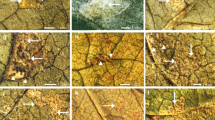Abstract
During investigations in the Middle East on biological control agents of skeleton weed (Chondrilla juncea L.), a coccid,Neomargardodes chondrillae Arch., was found to be highly damaging, its attacks on the rootstock of skeleton weed caused it to split, and reduced the viability of the plant. In N. W. Iran the coccid plays an important role in the reduction ofChondrilla populations in nature. The biology and ecology of the coccid were studied. Under field conditionsN. chondrillae was found to attackLactuca orientalis (Boiss) andCichorium intybus L., wildCompositae related toC. juncea, so that its use in biological control would pose risks to certain cultivated plants.
Résumé
Des recherches effectuées au Moyen Orient sur les agents de lutte biologique contreChondrilla juncea L. ont révélé qu'une cochenille:Neomargarodes chondrillae Arch. était un des agents causant les plus grands dommages à cette plante. Ses attaques sur les rhizomes les font se fendiller et réduisent ainsi la viabilité de la plante. Dans le nord ouest de l'Iran la cochenille joue un rôle important dans la réduction des peuplements naturels deChondrilla. Une étude fut faite sur la biologie et l'écologie de cette cochenille. Cependant, dans des conditions naturellesN. chondrillae se révélant, être aussi nuisible àLactura orientalis (Boiss.) etCichorium intybus L. composées sauvages proches deC. juncea, il semble que son utilisation en lutte biologique puisse être préjudiciable à certaines plantes cultivées.
Similar content being viewed by others
References
Arkhangelskaja, A. D. — 1935.Neomargarodes chondrillae Kram. —Czerwecy Sred, Asii, 24, 27.
Caresche, L. &Wapshere, A. J. — 1974. Biology and host specificity of theChondrilla, gall miteAceria chondrillae (G. Can.) [Acarina, Eriophyidae]. —Bull. Entomol. Res., 64, 183–192.
— — 1975a. TheChondrilla gall midge,Cystiphora schmidti (Rübsaamen) [Diptera, Cecidomyiidae]. II. Biology and host specificity. —Bull. Entomol. Res., 65, 55–64.
— — 1975b. Biology and host specificity of theChondrilla root mothBradyrrhoa gilveolella (Treischke) [Lepidoptera, Phycitidae]. —Bull. Entomol. res., 65, 171–185.
Hasan, S. — 1972. Specificity and host specialization ofPuccinia chondrillina. —Ann. Appl. Biol., 72, 257–263.
Hasan, S. &Wapshere, A. J. — 1973. The biology ofPuccinia chondrillina a potential biological control agent of skeleton weed. —Ann. Appl. Biol., 74, 325–332.
Hasan, S. & Wapshere, A. J. — 1977. Biology and host specificity of theChondrilla crown moth,Oporopsamma wertheimsteini Rebel [Lepidoptera, Tortricidae]. — Bull. Entomol. Res, 67.
Jakubski, K. W. — 1965. A critical revision of the familiesMargarodidae andTermitococcidae [Hemiptera, Coccoidea]. —British Museum Nat. Hist., Lond., pp 185.
Rudakova, K. V. — 1932. TheChondrilla scale insect, its life-cycle and its role in the formation of calluses. —Trans. Rubber & Guttapercha Inst. Leningrad, 6, 55–61.
Wahba, W. K. — 1970. A method to measure the percentage of attack of organisms in the field.Proc. Int. Symp. Biological Control Weeds, Delemont 1969, C.I.B.C. Misc., Publ. No 1, 91–93.
Walter, H. &Lieth, H. — 1960. Klimadiagram Weltatlas. —Gustav Fischer, Jena.
Wapshere, A. J., Hasan, S., Wahba, W. K. &Caresche, L. — 1974. The ecology ofChondrilla juncea in the western Mediterranean. —J. Appl. Ecol., 11, 783–800.
Author information
Authors and Affiliations
Additional information
This work conducted whilst located at CSIRO Biological Control Unit, Tehran, Iran.
Rights and permissions
About this article
Cite this article
Hasan, S. Biology of the root coccid,Neomargarodes chondrillae [Hem.: Margarodidae], living onChondrilla juncea and related plants. Entomophaga 23, 25–30 (1978). https://doi.org/10.1007/BF02371987
Issue Date:
DOI: https://doi.org/10.1007/BF02371987




